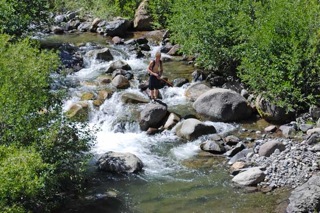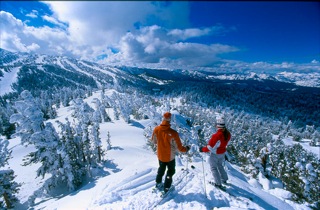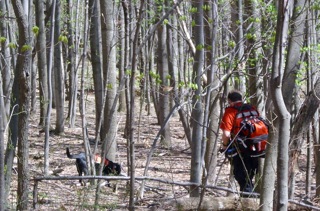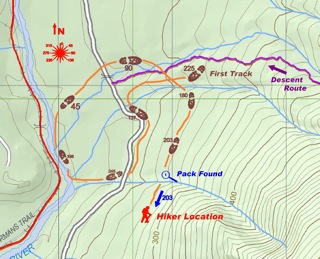Children (6 to 12 years)- Their navigational and direction skills are much more developed.
- They are generally oriented to their normal familiar surroundings and become confused in a strange environment.
- They may intentionally run away to avoid punishment, gain attention, or sulk.
- Whether it is intentional or accidental circumstances, they often will not answer when called.
- Darkness usually brings on a willingness to accept help and be found.
- Children this age suffer from the same fears and problems that adults would, but with a greater sense of helplessness.
- The circumstances of loss often reflect their being transplanted into a foreign environment or surroundings by parents or other adults.

Lost Person Behavior
Elderly (above 65 years)- Often the person is suffering from senility of Alzheimer's disease.
They are easily attracted by something that strikes their fancy.Their orientation is to past environments rather than the present.Many pose the same supervision problems as children.The more active and lucid ones are likely to over-extend and exhaust themselves rapidly which can result in heart attack or other potentially fatal complications.They are often hard of hearing or deaf.Hunters- Tend to concentrate on game rather than navigation or surroundings.
In the excitement of pursuant game, they are often led into downfall areas, boulder fields, underbrush, and deep snow with little regard for exhaustion or navigation.They tend to over extend themselves into darkness and push beyond physical capabilitiesThey are typically unprepared for extremely foul weather

Fishermen- Generally, they are very well oriented because of the directional flow of a river or the position of a lake.
- The reason they are averse is most often accident related, such as slipping into the water, falls over cliffs trying to move up or down stream, or swept off feet in fast moving water.
- A very high percentage of this category is boat related.
- Often this will be a recovery mission.
See
water search
for more information.Climbers- The individuals in this category are generally well equipped and self sufficient.
They tend to remain on or near designated routes.A primary factor for these incidents is weather or hazardous conditions which limit an individual's abilities.Other major factors are falling derby and
avalanche.
Technical expertise is generally needed for both search and recovery.

Lost Person Behavior
Skiers- Most are young, generally under 35
Almost all are in good physical and mental condition.One in three have "much" experience, and significant numbers have "some" experience. The subjects are generally well equipped and clothed.The following patterns have emerged in analyzing actual behavioral cases:- 60% had some sort of survival training.
- The subjects generally caused their own situation through human error.
- Weather was a factor 33% of the time and darkness 20% of the time.
- Most became lost because they became disoriented or misjudged time and distance.
- 20% of the subjects had either a poor map, or no map at all.
- Once lost, they generally followed paths, trails, or drainages.
- 50% were mobile while lost.
- 54% were found within 2 miles of the PLS; 82-85% were found within 5 miles.
- 83% did not move more than 24 hours.
- 30-45% moved at night.
- Almost all were communicative to the searchers.
- 50% found themselves.
- 50% were found by the SAR effort using hasty searches and visual tracking.
Other Lost Persons and Overdue (walkaways, campers, mushroom hunters, etc.)
- There are generally more missions for younger (under 8) and older (over 60) subjects.
Subjects are generally in good physical condition and 65 - 70% are in good mental condition.Incidents are generally caused by the subject's human error.General Information Relevant to the Prediction of Lost Subject Behavior
Weather
- Restricts the subjects movements
- Principle contributor to hypothermia
Time criticality of the situation may call for increased efforts.
Personality
- Consider the aggresive person versus the ponderer or pessimist.
- Has a substantial effect on the person's ability to survive.
Physical Condition
- Are capabilities encumbered or not?
- A poor condition means an increased susceptibility to environmental injury (hypothermia).
- Has a direct bearing on the distance a subject will travel.
Medical Problems
- Anything that could possibly precipitate abnormal behavior.
- Could have a direct bearing on the distance a subject could travel.

By analyzing the behavior of past lost persons in similar situations, you might be able to "predict" what the subject you are now looking for might do, where he or she might go, or where they might be.
There are many things that a lost person might do that will affect both the search strategy and their own survivability. An awareness of these points may well prove crucial in revamping a search plan at regular intervals.
- The ability of the subject to either build or seek shelter and get a fire started. Does the subject have the knowledge, skills, and/ or resources to do these things?
Campsites or fire circles will provide clues as the search progresses. Fires are also an extremely good signal of distress, while shelters in general, are good camouflages.
- Discarding equipment or clothing is very typical of individuals in the latter stages of hypothermia or exhaustion. Although these items provide clues to the subject's whereabouts, they also point to a deteriorating condition with regard to the subject's ability to cope with the environment or situation.
- Often times an individual will develop an overwhelming sense of abandonment which results in a "do nothing attitude". They simply refuse to believe anyone is out looking for them and as a result do not call or make signals of any kind. Some have gone as far as to ignore helicopters flying overhead.
- Whether or not a lost person will be detectable is tremendously important to search planning. The lost hunter who is dressed in bright clothing and able to respond is a great contrast to the young child who has been instructed not to speak or respond to strangers, and is dressed in dark clothing. Mentally handicapped individuals can also present very difficult problems in detectability.
- Travel aids provide avenues of little resistance for subjects and sometimes will be used extensively. Travel aids are pathways, old railroad beds, abandon roads, game trails, streams, clearcuts, powerline right-of-ways or any area that provides a sense of direction and a path of little resistance. It is important to note that not all subjects will use travel aids even though they are available.
- Weather and visibility play an important role in determining potential activities of a lost subject. Impeding bad weather is obviously a threat to life, but perhaps a more immediate concern to the search manager is the fact that it may force the subject to stop and seek shelter.
If the lost person is no longer mobile, SAR resources may have a chance for confinement. Visibility can have the same effect (darkness or extreme foggy conditions can immobilize the subject).
If the subject does move under these conditions, it will most likely be random wandering that could further complicate the search effort. Attractions such as roads or lights at night would not be effective.
Mental Impact on the Lost Person
- The mental impact of being lost or disoriented varies with individuals but is generally characterized by a shock-like behavior and disbelief. Contrary to popular belief, panic is seldom present.
It appears that a complete loss of contact with known references results in feeling similar to vertigo. The subject often feels that the environment is closing in around him/her and there is an intense urge to run, break out, to find a trail or some familiar reference in that environment.
- After a period of time that varies with each individual, all subjects seem to get control of their emotions. (True in adults, but not necessarily of children). Personal conflicts seem to develop between the conscious and subconscious minds about developing a plan of action appropriate for the situation.
Eventually, a course of action that seems to offer the highest degree of probable survival, is decided on. This may or may not be a rational or logical decision.
- If the lost person is overcome by a fear, it is possible that it may over-ride normal behavior and directly impact the outcome of the situation. Basic fears are always with us, and having fears is not abnormal.
Everyone is afraid of the dark at some time because it masks one of our five senses. Fear of being alone, animals, suffering, death, and many others all are basic fears about the unknown. The impact of these fears tends to be directly related to how well a person handles unknown or unexpected occurrences in daily life.
- Many times there will be a fluctuation of thought from a sense of abandonment to a fear about what others will say when the situation is over.
- All of these may lead to poor judgement and irrational behavior. It is imperative to investigate a subject's personality, background, experience and recent mood in order to more accurately predict some type of behavior. Mental attitude is critical because despair may cause a subject to ignore or entirely disregard obvious aids to rescue.
Evaluation Of circumstance Of Loss
- The circumstances by which an individual became lost, and thorough evaluation of the surrounding terrain are both important to establishing a search plan. In general, there are three major categories of circumstances to consider.
- Known location - the individual was at a semi-familiar location such as a home, campground or playground, etc.
- Enroute - the individual was traveling a route with one or more individuals and became separated.
- No specific location - the individual is in a wilderness area or relatively inaccessible location.
 Map and Terrain Analysis is useful in predicting lost person behavior. Confusion factors on a trail, mazes, minor and major barriers, natural routes, or travel aids and attractions should be identified and marked.
Map and Terrain Analysis is useful in predicting lost person behavior. Confusion factors on a trail, mazes, minor and major barriers, natural routes, or travel aids and attractions should be identified and marked.Put yourself in the subject's shoes - If it's a hunter you're looking for, where would they have gone? What about a berry picker? Where do the best berries grow?
Compile a subject profile and update it regularly.
Return from "Lost Person Behavior" to "Education"